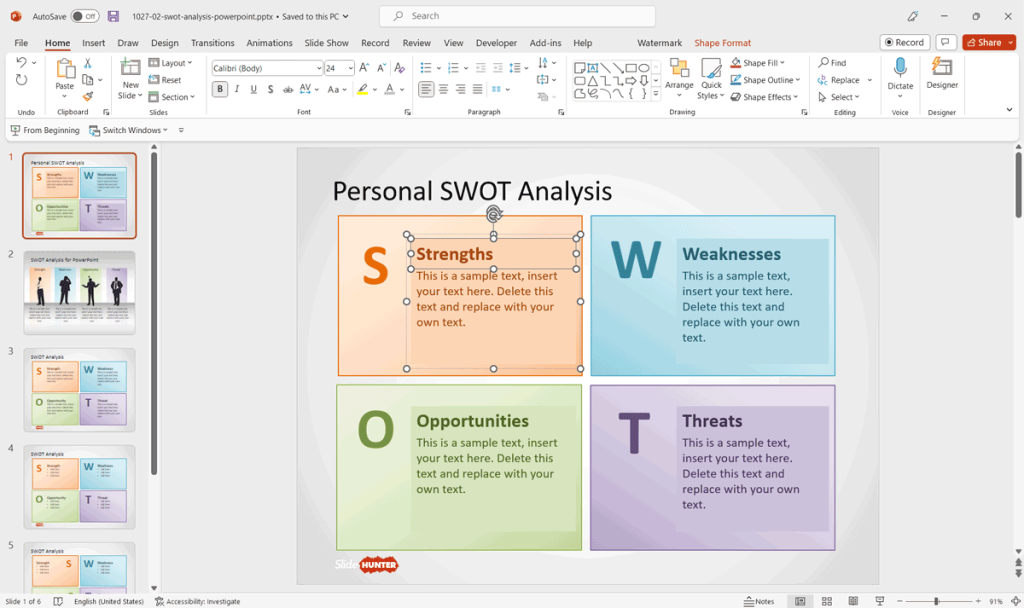A personal SWOT analysis is a self-assessment tool used to identify your strengths, weaknesses, opportunities, and threats. It can help you gain a better understanding of yourself and your abilities, as well as identify areas for personal and professional development.

A personal SWOT analysis can be a valuable tool in finding a new job, during the interview process, or when requested by a hiring manager. When looking for a new job, conducting a personal SWOT analysis can help you identify your strengths and highlight your unique selling points to potential employers. It can also help you identify areas for improvement and develop a plan for professional development.
During an interview process, a personal SWOT analysis can help you prepare and answer questions related to your strengths, weaknesses, opportunities, and threats. It can also demonstrate your self-awareness and ability to reflect on your personal and professional development.
A hiring manager may also request a personal SWOT analysis as part of the recruitment process to better understand your potential fit with the organization and identify areas for development. Providing a well-constructed personal SWOT analysis can showcase your self-awareness and commitment to personal and professional growth, which can be attractive to employers.
How to Conduct a Personal SWOT Analysis?
To conduct a personal SWOT analysis, you must identify your strengths, such as skills and qualities that give you an advantage, and your weaknesses, such as areas where you may lack skills or experience. You must also identify opportunities that could benefit you in achieving your goals, such as new technologies or market changes, and threats that could impede your progress, such as competition, economic changes, or personal challenges.
To conduct a personal SWOT analysis, you can use a SWOT analysis template, which typically consists of four quadrants: Strengths, Weaknesses, Opportunities, and Threats. Here is a brief overview of each quadrant and how to use them in a personal SWOT analysis:
- Strengths: In this quadrant of a personal SWOT slide, you should identify your personal strengths, such as your skills, abilities, and qualities that give you an advantage in achieving your goals. For example, you may be a good communicator, have excellent problem-solving skills, or have a strong work ethic.
- Weaknesses: In this quadrant, you should identify your personal weaknesses, such as areas where you may lack skills or experience, or personal qualities that may hold you back. For example, you may struggle with public speaking, have difficulty managing your time, or be easily distracted.
- Opportunities: In this quadrant of the SWOT slide, you should identify opportunities that could benefit you in achieving your goals, such as new technologies, new markets, or changes in the industry or job market. For example, you may be able to take advantage of a new training program or a growing demand for your skills.
- Threats: In this quadrant, you should identify potential threats that could impede your progress, such as competition, economic changes, or personal challenges. For example, you may face increased competition for jobs, a changing job market, or personal challenges such as health issues or financial difficulties.
By completing a personal SWOT analysis, you can gain insight into your personal strengths and weaknesses, as well as identify opportunities for growth and development. This can help you make more informed decisions about your career and personal life, and ultimately achieve your goals.
To help you preparing a compelling personal SWOT analysis presentation, you can use an editable Personal SWOT Analysis PPT template or a personal SWOT analysis template for Google Slides instead. In our website, we have a lot of free editable SWOT templates that you can reuse to save time and effort.
A personal SWOT analysis template is a helpful tool to use when conducting a self-evaluation. The template typically consists of four quadrants, each representing a different aspect of the analysis. These quadrants include strengths, weaknesses, opportunities, and threats.
Using a template can help guide your thinking and ensure you cover all relevant areas of your personal SWOT analysis. It can also help organize your thoughts and make it easier to see patterns and connections between different aspects of your analysis.
In the strengths quadrant, you can list all of your personal strengths, such as skills, qualities, and experiences, that give you an advantage. In the weaknesses quadrant, you can list areas where you may lack skills or experience or personal qualities that may hold you back.
The opportunities quadrant allows you to identify potential opportunities that could benefit you in achieving your goals, such as new technologies or changes in the job market. Finally, the threats quadrant lets you identify potential threats that could impede your progress, such as competition, economic changes, or personal challenges.
Using a personal SWOT analysis template can help you conduct a more thorough and comprehensive analysis of yourself. It provides a structured framework to work within, making it easier to identify areas for personal and professional development. By using a template, you can gain valuable insights into yourself and make more informed decisions about your career and personal life.
Completing a personal SWOT analysis helps you gain insight into your strengths and weaknesses, as well as identify opportunities for growth and development. It helps you make more informed decisions about your career and personal life, ultimately helping you achieve your goals.
